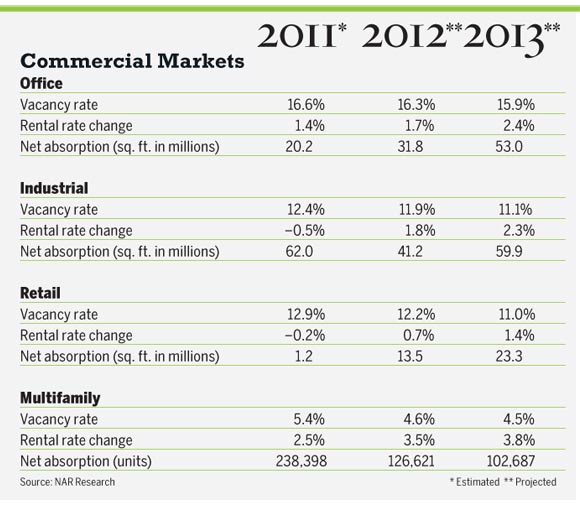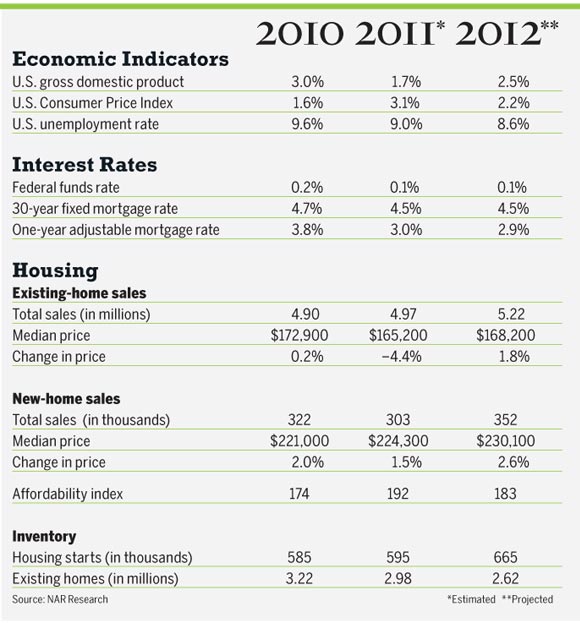Slowly, a recovery seems to be taking hold. “More jobs, rising rents, a rising stock market, and continuing high affordability conditions” are combining to get more people into the market, says NAR Chief Economist Lawrence Yun. On the commercial side, all the major sectors are seeing improving fundamentals, and more positive trends are expected in 2012. Against that backdrop, we asked some of you to tell us what you expected to be your best source of business this year.
Residential
With prices expected to rise slightly in both existing- and new-home sales in 2012, buyers may not get quite the same bargain they got last year. Still, conditions remain favorable for buyers, and NAR is forecasting a 5 percent increase in existing-home sales over 2011. Here are three pockets of opportunity.
1. International investment. With U.S. real estate values down, a favorable currency exchange rate, and the promise of a stable place to invest while Europe deals with debt crises in Greece, Spain, Italy, and other countries, foreign buyers continue to stream steadily to the United States.
“People [are trying] to move their cash somewhere safer,” says Brian Block, broker-associate with RE/MAX Allegiance in Arlington and McLean, Va.
Elaine Murphy Carlson, a broker-associate with RE/MAX Palos Verdes Realty in Palos Verdes Peninsula, Calif., says foreign investors who stayed away during the darkest days of the financial crisis are coming back. Indeed, NAR’s 2011 Profile of International Home Buying Activity shows foreign households bought $82 billion worth of residential real estate last year, up from $66 billion in 2010.
Block says the investors he works with are professionally successful individuals with cash available. “They will buy when they see a good deal,” he says. He has gained investor business by demonstrating a solid knowledge of the market and finding networking opportunities, from local Chamber of Commerce meetings to regular real estate industry functions.
2. Distressed inventory in centrally located neighborhoods. Affordable housing in inner-ring suburbs or center city areas may be real estate’s sweet spot in 2012, Block says, because buyers today aren’t looking just for bargains, they’re looking for convenience and lifestyle amenities. A 2011 survey of U.S. adults conducted for NAR by research firm Belden Russonello & Stewart seems to support Block’s assertion. Nearly six in ten adults (58 percent) said they’d prefer to live in a neighborhood with a mix of houses and stores and other businesses within an easy walk.
Block says he has seen first-hand the shift among both first-timers and retirees toward smaller, close-to-the-city homes in walkable neighborhoods. He reaches out to potential clients by using social media and blogging to talk about issues like lengthy commutes.
3. Rentals. Rising rental rates in many markets are making home ownership a more appealing option, especially for those seeking to buy distressed property. But many households aren’t financially ready to buy, either because of credit dings or the continuing overly tight credit restrictions of lenders. Others are waiting to make sure home prices have bottomed out. That’s why many real estate companies have shifted their business model to include rental and property management.
Bill Bloomberg, broker-owner of Distinctive Rental Homes in Eden Prairie, Minn., opened his business in 2011 with high-end rentals as his central focus, providing assistance to both renters and owners who choose to rent rather than sell their property.
Bloomberg, who has nine years of experience working in conventional real estate sales, says helping owners find tenants is a great way to retain clients who might otherwise have turned to another real estate professional.
“If a listing isn’t selling, it’s usually because of price. However, most owners are going to try to switch to another agent first to see if that will make a difference,” Bloomberg says. “Presenting an option such as renting can prevent that from happening.”
And when owners opt to rent their property rather than sell it, they may be providing a unique opportunity, helping renters get one foot into a neighborhood that’s currently beyond their buying power, says Gina Chirico, sales associate with Lattimer Realty in Fairfield, N.J.
To attract rentals and tenants, Bloomberg says, he keeps up with sites that renters frequent such as Craigslist and syndication sites such as ListHub, Postlets, and vFlyer. He also relies on referrals, listings bringing other listings, and basic cold calling.
“As long as wages go down, traditional homes sales will suffer,” Bloomberg says. “People say I’m pessimistic, but understanding how the economy works has helped me make the adjustments I needed to make it in my business.” Another plus, he says: Rentals are less stressful than sales.
Meanwhile, Bloomberg recognizes that today’s renters could well become buyers of the future. The majority of renters (63 percent) say they are at least somewhat likely to purchase a home in the future. Among them, young adults (age 18 to 24) have the strongest aspirations for home ownership, according to an NAR survey of 3,793 adults conducted by Harris Interactive and released in January 2011.
Commercial
All of commercial real estate’s main sectors — office, industrial, retail, and multifamily—began improving last year, but a solid turnaround is still another year away at least, according to Yun’s research. Here’s a look at what to expect in each sector.
Office. The office sector is seeing improving fundamentals, particularly in larger metro areas, with absorptions this year expected to be twice that of completions. Yun is forecasting vacancies in 2012 to drop from 17.3 percent this year to 16.3 percent next year and 15.9 percent in 2013, with the 2011 median rental rate of just under $28 per square foot, increasing 1.7 percent in 2012 and 2.4 percent in 2013.
Greg Schenk, SIOR, of The Schenk Co. Inc., in Columbus, Ohio, says he’s capturing business in today’s climate by encouraging clients to think about renewing their leases well before they come due so that they can take advantage of today’s attractive interest rates. It’s also a good time to negotiate on behalf of tenants with building owners who need to refinance the debt on their building, because they’re looking for long-term leases that will put them in a stronger position with lenders. Under such conditions, owners who aren’t willing to offer a favorable renewal deal risk losing tenants.
“I just helped a small retailer by showing the owner there were 10 other places within a mile that would fit the tenant,” says Schenk. “The landlord said, ‘Look, you already have this renewal option for x amount,’ so I showed him the other properties that would pay for the tenant to move and reduce the rent 30 percent. We got the landlord to reduce the lease by 15 percent, my client didn’t have to move, and they extended for five years.”
Industrial. Warehouses, distribution centers, and manufacturing plants on a national basis are also seeing strong absorption. It’s now three times as high as completions. Even so, Yun expects vacancy rates to rise for another year, from about 11.1 percent to 11.9 percent next year. That’s because there remains slack in the market. Vacancies should drop back down to 11.1 percent in 2013. The rental rate, at a median of $4.60 per square foot, will rise 1.8 percent in 2012 and 2.34 percent in 2013.
David Murphy, CCIM, SIOR, of CB Richard Ellis in Orlando, says he’s reaching out more to e-commerce companies looking to expand their warehousing and distribution capabilities and to “m-commerce” companies, e-commerce companies that focus on consumers who make purchases on mobile devices.
“Tenants today are more comfortable signing longer-term leases,” he says. “Two or three years ago, they only wanted to sign leases for 18 months, but they’re more comfortable today with where their business is going. So we’re seeing more three-, five-, and even 10-year leases, and they can get really attractive rental terms. Whenever we close a deal with one of these companies,” he adds, “we pull that company’s SIC code [a federal “standard industrial classification” code for categorizing business types], and we’ll reach out to companies in the same field and say, ‘Hey, we just represented a company that had a requirement similar to what you might have and we’re available to assist you in your real estate needs.’ ”
Confidence in the business climate is creeping back into his central Florida market, among both building owners and tenants. That means negotiations are becoming more tactical, with neither side having a market advantage, particularly for deals involving larger properties. “We have very little inventory in properties of 100,000 square feet or above,” he says.
As with the office market, because properties with long-term leases are more “bankable,” says Stuart Kingma, SIOR, of NAI Wisinski of West Michigan in Grand Rapids, he can help both tenants and owners get what they want by negotiating favorable rates for the tenants in exchange for a strong long-term lease. “We see how lenders are solving issues on a broad front, and the information gathered from that experience allows us to assist clients with an individual issue,” says Kingma.
Retail. Although sales picked up during the 2011 holiday season, retail continues to struggle the most as consumers continue to retrench on their spending. Yun is forecasting vacancies to rise from 11.1 percent to 12.2 percent next year before dropping to 11 percent in 2013. The rental rate, at just under a median of $19 a square foot, is projected to rise 0.7 percent next year and 1.4 percent in 2013. Absorption could pick up if there’s improvement in the dollar volume of retail sales, which remains below its pre-recession peak.
Palmer Bayless, CCIM, of Emerge Real Estate Services, in Roswell, Ga., outside of Atlanta, leverages social media to help communicate his expertise in locating and negotiating retail deals and build his brand as a specialist with his two high-profile clients, Starbucks and Pet Supermarket. “The first thing every potential client does before working with you is to Google your name,” he says. So he maintains a high-profile presence on LinkedIn and writes about retail real estate strategy on his blog. By covering topics such as signage, demographics, and traffic patterns, he’s able to demonstrate his grasp of market and showcase his transactions. “It ultimately comes down to the relationships, not social media, but this gets my name out there,” he says. (For a more in-depth look at retail trends, see page 16.)
Multifamily. Apartment rentals are once again expected to be the best-performing commercial sector. For the second year in a row, absorption of existing units is far outpacing completions of new units: Almost 170,000 units were absorbed in 2011, against completions of about 38,000 units. In 2010 the spread was even wider. As a result, vacancies continue to drop and rental rates continue to rise.
Yun is forecasting multifamily vacancies to drop to 4.6 percent in 2012 from 5.3 percent this year, and to drop to 4.5 percent in 2013. The rental rate, at a median of $1,066 per unit, is expected to increase 3.5 percent next year and 3.8 percent in 2013.

Related Posts
- Has The Real Estate Collapse Begun? Florida Homes Decline Hits A 13-Year High
- Simon Property Group reports rise in quarterly real estate FFO on strong leasing demand
- Real Estate Broker Says $600K Homes Will Hit $1 Million — ‘I Hate To Burst Your Bubble, But There Is No Bubble And There Never Will Be’
Tags: Housing Market Conditions, Housing Market News, Real Estate Investment
